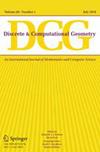受限伯克霍夫多边形和艾哈特周期坍缩
IF 0.6
3区 数学
Q4 COMPUTER SCIENCE, THEORY & METHODS
引用次数: 0
摘要
我们证明,通过对 "最长递增子序列 "施加额外的不等式限制,从伯克霍夫多胞形得到的多胞形具有诚实多项式的埃尔哈特准多项式,尽管它们在一般情况下只是有理多胞形。为此,我们定义了与某个格尔芬-策林多面体的连续、片断线性偏射。这种偏射不是积分等价,但它以适当的方式尊重格点,暗示这两个多面体具有相同的艾尔哈特(准)多项式。事实上,该双射本质上是罗宾逊-申斯特-克努斯对应关系。本文章由计算机程序翻译,如有差异,请以英文原文为准。
Restricted Birkhoff Polytopes and Ehrhart Period Collapse
We show that the polytopes obtained from the Birkhoff polytope by imposing additional inequalities restricting the “longest increasing subsequence” have Ehrhart quasi-polynomials which are honest polynomials, even though they are just rational polytopes in general. We do this by defining a continuous, piecewise-linear bijection to a certain Gelfand–Tsetlin polytope. This bijection is not an integral equivalence but it respects lattice points in the appropriate way to imply that the two polytopes have the same Ehrhart (quasi-)polynomials. In fact, the bijection is essentially the Robinson–Schensted–Knuth correspondence.
求助全文
通过发布文献求助,成功后即可免费获取论文全文。
去求助
来源期刊

Discrete & Computational Geometry
数学-计算机:理论方法
CiteScore
1.80
自引率
12.50%
发文量
99
审稿时长
6-12 weeks
期刊介绍:
Discrete & Computational Geometry (DCG) is an international journal of mathematics and computer science, covering a broad range of topics in which geometry plays a fundamental role. It publishes papers on such topics as configurations and arrangements, spatial subdivision, packing, covering, and tiling, geometric complexity, polytopes, point location, geometric probability, geometric range searching, combinatorial and computational topology, probabilistic techniques in computational geometry, geometric graphs, geometry of numbers, and motion planning.
 求助内容:
求助内容: 应助结果提醒方式:
应助结果提醒方式:


